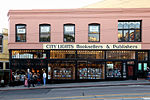The Condor Club nightclub is a striptease bar or topless bar in the North Beach section of San Francisco, California The club was a small bar on the corner of Columbus and Broadway for most of the 1900s. Known as the Pisco Bar, it was purchased by Mario Puccinili who called it Pucci's House of Pisco. It was sold a couple of times and in 1958, was owned by Gino Del Prete. Pete Mattioli became Gino's partner in 1958 and promoted the club, which became a jumpin’ jivin’ entertainment center of North Beach, featuring George and Teddy and the Condors. In 1963, they hired a cocktail waitress named Carol Doda. She went on to fame wearing and dancing in the new topless swimsuit on June 19, 1964. The club has thrived since that date. The club is located at the corner of Broadway and Columbus Avenue. The large lit sign in front of the club featured a picture of Carol Doda. The sign had red lights on the image of her breasts. She was the first topless entertainer there and the most famous. Her première topless dance occurred on the evening of June 19, 1964.The club went "bottomless", with the dancers performing fully nude, on September 3, 1969. In 1972, bottomless nude dancing became illegal in establishments that served alcohol in California, but Carol Doda continued dancing there topless until 1986.
A bizarre death occurred at the Condor Club in November 1983. Bouncer Jimmy Ferrozzo and his girlfriend, exotic dancer Theresa Hill, decided after hours, to have sexual intercourse on the famous white piano on which Carol Doda made her entrance, being lowered from the ceiling by cables. They accidentally hit the "on" switch, and the piano rapidly rose to the ceiling, trapping the couple. Ferrozzo was asphyxiated, while Hill survived only because she was thinner than her companion.The club closed in 2000, but soon reopened as a sports bar/bistro. Between 2005 and 2007, it was Andrew Jaeger's House of Seafood & Jazz, a branch of the owner's original restaurant in New Orleans. However, in August 2007, it once again became the Condor Club, once more featuring go-go dancers. The current Condor Club is branded as "San Francisco's Original Gentlemen's Club."









